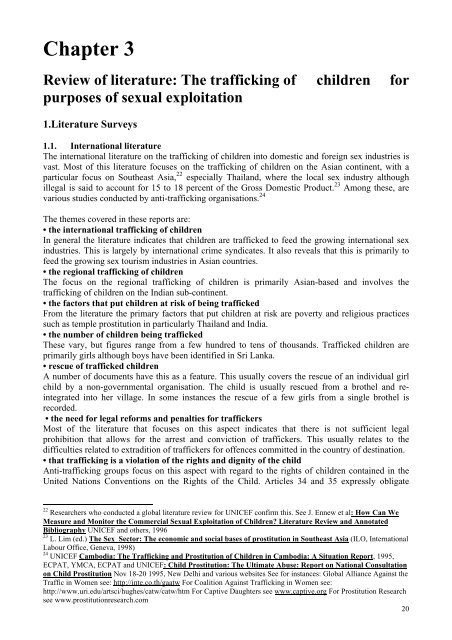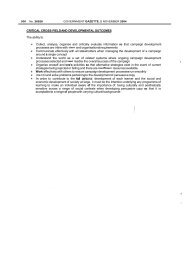The trafficking of children for purposes of sexual exploitation
The trafficking of children for purposes of sexual exploitation
The trafficking of children for purposes of sexual exploitation
You also want an ePaper? Increase the reach of your titles
YUMPU automatically turns print PDFs into web optimized ePapers that Google loves.
Chapter 3<br />
Review <strong>of</strong> literature: <strong>The</strong> <strong>trafficking</strong> <strong>of</strong> <strong>children</strong> <strong>for</strong><br />
<strong>purposes</strong> <strong>of</strong> <strong>sexual</strong> <strong>exploitation</strong><br />
1.Literature Surveys<br />
1.1. International literature<br />
<strong>The</strong> international literature on the <strong>trafficking</strong> <strong>of</strong> <strong>children</strong> into domestic and <strong>for</strong>eign sex industries is<br />
vast. Most <strong>of</strong> this literature focuses on the <strong>trafficking</strong> <strong>of</strong> <strong>children</strong> on the Asian continent, with a<br />
particular focus on Southeast Asia, 22 especially Thailand, where the local sex industry although<br />
illegal is said to account <strong>for</strong> 15 to 18 percent <strong>of</strong> the Gross Domestic Product. 23 Among these, are<br />
various studies conducted by anti-<strong>trafficking</strong> organisations. 24<br />
<strong>The</strong> themes covered in these reports are:<br />
• the international <strong>trafficking</strong> <strong>of</strong> <strong>children</strong><br />
In general the literature indicates that <strong>children</strong> are trafficked to feed the growing international sex<br />
industries. This is largely by international crime syndicates. It also reveals that this is primarily to<br />
feed the growing sex tourism industries in Asian countries.<br />
• the regional <strong>trafficking</strong> <strong>of</strong> <strong>children</strong><br />
<strong>The</strong> focus on the regional <strong>trafficking</strong> <strong>of</strong> <strong>children</strong> is primarily Asian-based and involves the<br />
<strong>trafficking</strong> <strong>of</strong> <strong>children</strong> on the Indian sub-continent.<br />
• the factors that put <strong>children</strong> at risk <strong>of</strong> being trafficked<br />
From the literature the primary factors that put <strong>children</strong> at risk are poverty and religious practices<br />
such as temple prostitution in particularly Thailand and India.<br />
• the number <strong>of</strong> <strong>children</strong> being trafficked<br />
<strong>The</strong>se vary, but figures range from a few hundred to tens <strong>of</strong> thousands. Trafficked <strong>children</strong> are<br />
primarily girls although boys have been identified in Sri Lanka.<br />
• rescue <strong>of</strong> trafficked <strong>children</strong><br />
A number <strong>of</strong> documents have this as a feature. This usually covers the rescue <strong>of</strong> an individual girl<br />
child by a non-governmental organisation. <strong>The</strong> child is usually rescued from a brothel and reintegrated<br />
into her village. In some instances the rescue <strong>of</strong> a few girls from a single brothel is<br />
recorded.<br />
• the need <strong>for</strong> legal re<strong>for</strong>ms and penalties <strong>for</strong> traffickers<br />
Most <strong>of</strong> the literature that focuses on this aspect indicates that there is not sufficient legal<br />
prohibition that allows <strong>for</strong> the arrest and conviction <strong>of</strong> traffickers. This usually relates to the<br />
difficulties related to extradition <strong>of</strong> traffickers <strong>for</strong> <strong>of</strong>fences committed in the country <strong>of</strong> destination.<br />
• that <strong>trafficking</strong> is a violation <strong>of</strong> the rights and dignity <strong>of</strong> the child<br />
Anti-<strong>trafficking</strong> groups focus on this aspect with regard to the rights <strong>of</strong> <strong>children</strong> contained in the<br />
United Nations Conventions on the Rights <strong>of</strong> the Child. Articles 34 and 35 expressly obligate<br />
22 Researchers who conducted a global literature review <strong>for</strong> UNICEF confirm this. See J. Ennew et al: How Can We<br />
Measure and Monitor the Commercial Sexual Exploitation <strong>of</strong> Children? Literature Review and Annotated<br />
Bibliography UNICEF and others, 1996<br />
23 L. Lim (ed.) <strong>The</strong> Sex Sector: <strong>The</strong> economic and social bases <strong>of</strong> prostitution in Southeast Asia (ILO, International<br />
Labour Office, Geneva, 1998)<br />
24 UNICEF Cambodia: <strong>The</strong> Trafficking and Prostitution <strong>of</strong> Children in Cambodia: A Situation Report, 1995,<br />
ECPAT, YMCA, ECPAT and UNICEF: Child Prostitution: <strong>The</strong> Ultimate Abuse: Report on National Consultation<br />
on Child Prostitution Nov 18-20 1995, New Delhi and various websites See <strong>for</strong> instances: Global Alliance Against the<br />
Traffic in Women see: http://inte.co.th/gaatw For Coalition Against Trafficking in Women see:<br />
http://www.uri.edu/artsci/hughes/catw/catw/htm For Captive Daughters see www.captive.org For Prostitution Research<br />
see www.prostitutionresearch.com<br />
20
















